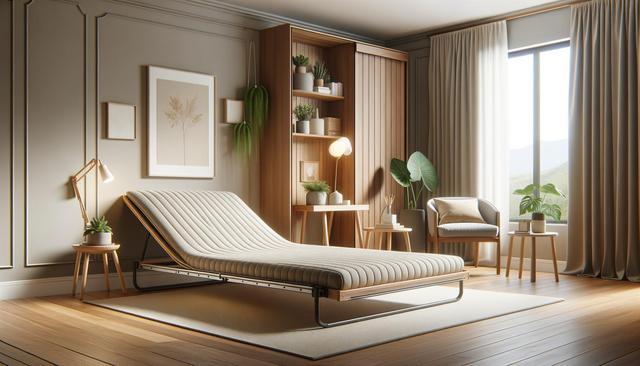Why Folding Beds Are Gaining Popularity
Folding beds have become a staple in modern home design, especially for those navigating the challenges of compact living. As urban living spaces become smaller and more expensive, the need for efficient and multifunctional furniture has grown significantly. Folding beds address this need by offering the convenience of a full-sized sleeping solution that can be neatly tucked away when not in use. This makes them an ideal choice for renters, city dwellers, and anyone embracing small apartment design.
These beds are particularly appealing because they align with current smart home trends, which emphasize functionality without sacrificing style. The shift toward minimalism and the desire to declutter living spaces have made folding beds more than just a practical option—they are now a design statement. Whether used in guest rooms, studios, or multifunctional living areas, folding beds provide a seamless blend of form and function.
Features That Make Folding Beds Stand Out
Modern folding beds are a far cry from their older, less comfortable counterparts. Today’s designs incorporate advanced materials, engineering, and thoughtful aesthetics. Some of the features that contribute to their popularity include:
- Sturdy frames made from lightweight yet durable metals or engineered wood
- High-density foam or memory foam mattresses for added comfort
- Easy-to-operate folding mechanisms that require minimal effort
- Stylish finishes and upholstery that match a variety of interior themes
These features contribute to their reputation as innovative foldable beds, allowing them to fit seamlessly into the demands of space-saving furniture. Some models also include extra storage compartments or are integrated into larger furniture pieces like cabinets or desks, making them a compelling solution for those looking to optimize every square foot of their living area.
Integrating Folding Beds Into Small Spaces
One of the greatest strengths of folding beds is their adaptability. They can be integrated into almost any room without overwhelming the space. In small apartment design, this flexibility is essential. Whether it’s a wall-mounted Murphy bed, a fold-out sofa bed, or a modular unit with hidden sleeping quarters, folding beds can be tailored to fit unique layouts and design preferences.
Here are a few ways folding beds can be effectively incorporated:
- Wall beds in studio apartments to quickly switch between bedroom and living room
- Foldable guest beds that store easily in closets or under existing furniture
- Convertible daybeds that serve as seating by day and sleeping space by night
By using folding beds as part of a broader compact living solution, residents can enjoy both functionality and style, without feeling cramped or cluttered.
Folding Beds and the Rise of Multifunctional Furniture
Folding beds are a key example of the growing trend toward multifunctional furniture. As homes become smarter and more efficient, each piece of furniture is expected to serve more than one purpose. This is especially true in urban living environments, where space is a premium commodity. Folding beds help meet this demand by transforming a single-use item into something versatile and dynamic.
When considering multifunctional furniture, folding beds often partner well with:
- Desk-bed hybrids for home offices that double as guest rooms
- Sofa beds in living rooms that accommodate overnight visitors
- Fold-down beds with shelves or cabinets to maximize vertical storage
These combinations support smart home trends by enabling homeowners to make the most of their space while still enjoying a high level of comfort and usability. The ability to transform a room’s purpose with a single piece of furniture is a valuable advantage in today’s housing market.
Choosing the Right Folding Bed for Your Home
Selecting the right folding bed involves considering both form and function. Start by evaluating your space and identifying what type of bed configuration fits your layout. For example, a wall bed might be perfect for long-term use in a small bedroom, while a rollaway bed might be better suited for occasional guests. Understanding your needs will guide you toward the most appropriate solution.
Other factors to consider include:
- Mattress type and thickness for comfort
- Ease of folding and storage
- Material durability and build quality
- Design compatibility with existing décor
With the wide variety of innovative foldable beds available on the market, there’s likely a model that aligns with your aesthetic and functional requirements. By focusing on quality and thoughtful design, it’s possible to find a folding bed that integrates effortlessly into any home environment, promoting both comfort and practicality.
Conclusion: Smart Living with Folding Beds
For individuals and families navigating the demands of compact living, folding beds offer a practical yet stylish solution. They align with the growing emphasis on space-saving furniture and multifunctional furniture, making them highly suitable for urban living and small apartment design. As smart home trends continue to evolve, folding beds stand out as a reliable and adaptable component of modern interior planning. Whether you’re furnishing a small guest room or designing a fully functional studio apartment, folding beds provide the versatility and innovation needed to make the most of your space.












